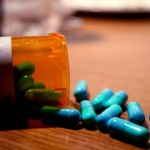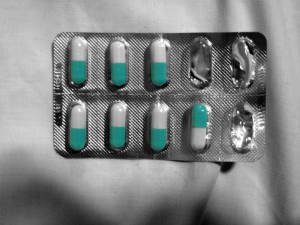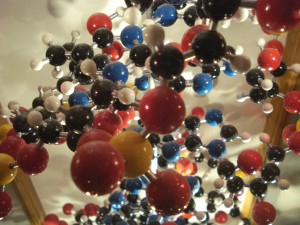
Large placebo effects (clinical improvement due to patients’ positive expectations and their experience that they are being cared for) are often seen in the treatment of many clinical conditions (see placebo reading links below).
In clinical trials of antidepressants, placebo effects account for as much as 80% of the effects of antidepressants (Kirsch et al, 2008), and have been increasing over the last 15 years (Dunlop et al, 2012).
The authors of a new study published in JAMA Psychiatry (Peciña et al, 2015) investigated the relationship between placebo and drug effects using molecular functional imaging of the mu-opioid receptor (MOR) system, which plays an important role in the regulation of stress, pain (Fields, 2004), and emotion (Hsu et al, 2013), social processes involved in pair bonding and parental behaviour (Panksepp et al, 1980; Løseth et al, 2014), as well as placebo analgesia (Levine et al, 1978; Eippert et al, 2009).

Double-blind placebos are about 80% as effective as antidepressants in randomised trials.
Methods
35 (medication-free) patients with Major Depressive Disorder (MDD) went through 2 phases.
Phase 1 (the placebo phase)
Patients underwent 1 week of placebo treatment (2 pills/day), in which they were told the pill was an antidepressant (active placebo) and 1 week of treatment with a pill they were openly told was a placebo (inactive placebo). The design was a “crossover”, meaning that half of the patients started with active, while the other half started with inactive, before they, after a 3 days pause (washout), were switched over to the “other” pill. Depression severity was assessed before and after each week period with the Quick Inventory of Depressive Symptomatology–Self-Report (QIDS-SR16).
At the end of each week of placebo treatment, they also underwent a Positron Emission Tomography (PET) scan, where endogenous MOR release was assessed. During the PET scan, patients also underwent an “acute placebo” with an intravenous (IV) injection (1ml) with 0.9% isotonic saline (every 4 min over 20 min), which is essentially a placebo. This was done at the end of “the active placebo” week, but not after “the inactive placebo”. Patients’ Impression of Severity (PIDS scale) – a single question (“From 0 to 100, how depressed do you feel now?”) – was asked after the “acute placebo” session.
Hence, there are two placebo effects to be looked at:
- A sustained (post-pre change in QIDS scores during active placebo compared to in inactive)
- An acute (depression rating after IV compared to no IV).
Phase 2 (the antidepressant phase)
The same patients subsequently underwent a 10-week treatment with an SSRI antidepressant (in most cases citalopram), in which depressive symptoms were assessed with QIDS every other week.

The editorial of this paper suggests it’s the first-ever pilot randomised clinical trial of open-label placebo in adult outpatients with a primary diagnosis of non-psychotic major depressive disorder.
Results
Patients showed both sustained (1.75 point reduction on the 0-27 QIDS scale when taking the active placebo) and acute (7 point reduction on the 0-100 PIDS scale after getting placebo IV compared to not getting IV) placebo improvement of depressive symptoms.
Baseline MOR activation in the Nucleus Accumbens (NAc) correlated with baseline QIDS (before starting the study) and predicted the magnitude of symptom improvement after 10 weeks of antidepressant treatment. However, there was no relationship between baseline MOR activation and (acute or sustained) placebo effects.
Placebo improvement correlated with increased MOR release in brain regions involved in regulation of stress and emotion, reward, and social processing (Sustained: subgenual anterior cingulate (sgACC), NAc, amygdala, and the midline thalamus; Acute: sgACC and amygdala).
Those patients who responded strongly to placebo also responded strongly to subsequent antidepressant treatment. Similarly, those with large placebo-induced MOR activations responded better to antidepressants.
Placebo-induced MOR increase in sgACC; NAc, THA, and amygdala predicted 43% of the variance of antidepressant response, whereas self-reported placebo improvement predicted 46% of the variance – combined, they explained 57% of the variance.

These findings support the view that open-label placebos are a possible first-line treatment for depression.
Discussion
There are at least two innovations of this paper that should be highlighted:
- It is the first to directly investigate the molecular mechanisms (the MOR neurotransmitter system) involved in placebo responses in MDD.
- Second, it elucidates, on both a molecular and psychophysical level, how placebo effects and drug effects on depressive symptoms in MDD might be related.
One possibility for the strong link between response to placebo and response to antidepressants is that the same placebo mechanisms, which are responsible for a large part of the symptom improvement, are involved in both phases. As the authors point out, however, it is also possible that the placebo effects interact, in a non-additive way, with antidepressant responses, perhaps with synergistic effects of placebo-induced MOR activation and drug-induced aminergic effects, which has also previously been suggested (Enck et al. 2013).
This has implications for RCTs, where it is generally assumed that the placebo effect is the same in both placebo and treatment arms, and that the effect in the placebo arm can simply be subtracted from the effect in the treatment arm. Furthermore, if endogenous placebo effects interacts with drug effects, initial screening for placebo responders in order to exclude them from further testing, which is a common practice in RCTs, might give a skewed picture of the how the drug might work in clinical practice.
There is an increasing push for “precision medicine” in medicine in general, and in psychopharmacological treatments in particular, due to the often-large variability in how well a given treatment works across individuals (see the precision medicine links below). It is therefore noteworthy that, not only did MOR activation accurately predict antidepressant responses (43% of variance explained), but simple (and very inexpensive) self-reports of placebo effects were equally accurate (46% of variance explained). Combined however, they predicted 57% of the variance, indicating that, although they largely overlap, each of them seem to explain some unique variance.
Strengths and limitations
There are many strengths of the study. Study design is generally very well controlled. A unique feature of the study is that it relates molecular and self-reported placebo responses to antidepressant responses within the same individuals. Moreover, the ability to compare two types of placebo effects: acute and sustained (which is mimicking the actual drug administration), is an important strength of the study. This is particularly relevant to the treatment of depression, where the time between onset antidepressant medication and symptom improvement is varying, and the neurobiological mechanisms whereby symptoms are improved are largely unknown.
One potential limitation is that the investigators were not blinded to the assignment to active and inactive conditions. This is however a relatively common practice in many placebo studies, but something that can potentially influence results. For example, some studies have found that investigators’ own expectations can (mostly non-deliberately) tilt results towards the expected direction (Graceley et al. 1985).
Another potential issue is that patients are dichotomously divided into two subgroups “placebo responders” and “placebo nonresponders” for some of the analyses, based on a certain cut-off point (patients’ original placebo responses are graded, and don’t naturally fall into either category). Although it is not unusual to do this, from a statistical standpoint it is often recommended not to reduce “rich data”, such as the individual magnitude of placebo response, to dichotomous responder/nonresponder subgroups (Royston et al. 2006). In principle however, one would not expect dramatically different results one way or the other.

This study relates molecular and self-reported placebo responses to antidepressant responses within the same individuals.
Links
Primary paper
Peciña M. et al (2015) Association Between Placebo-Activated Neural Systems and Antidepressant Responses: Neurochemistry of Placebo Effects in Major Depression. JAMA Psychiatry. doi:10.1001/jamapsychiatry.2015.1335 Published online September 30, 2015
Other references
Dunlop BW. et al (2012) A meta-analysis of factors impacting detection of antidepressant efficacy in clinical trials: the importance of academic sites. Neuropsychopharmacology 37.13: 2830-2836.
Eippert F. et al (2009) Activation of the opioidergic descending pain control system underlies placebo analgesia. Neuron, 63(4), 533-543.
Enck P. et al (2013) The placebo response in medicine: minimize, maximize or personalize?. Nature reviews Drug discovery, 12(3), 191-204. [PubMed abstract]
Fields H. (2004) State-dependent opioid control of pain. Nature Reviews Neuroscience, 5(7), 565-575.
Gracely R. et al (1985) Clinicians’ expectations influence placebo analgesia. The Lancet, 325(8419), 43.
Hsu DT, et al (2013) Response of the μ-opioid system to social rejection and acceptance. Molecular psychiatry, 18(11), 1211-1217.
Kirsch I. et al (2008) Initial severity and antidepressant benefits: a meta-analysis of data submitted to the Food and Drug Administration. PLoS Med 5.2: e45.
Levine J. et al (1978) The mechanism of placebo analgesia. The Lancet, 312(8091), 654-657.
Loseth GE, Ellingsen DM, Leknes S. (2014) State-dependent μ-opioid modulation of social motivation. Frontiers in behavioral neuroscience, 8.
Panksepp J. et al (1980) Endogenous opioids and social behavior. Neurosci. Biobehav. Rev. 4, 473–487. [PubMed abstract]
Royston P. et al (2006) Dichotomizing continuous predictors in multiple regression: a bad idea. Stat Med, 25(1), 127-141. [PubMed abstract]
Placebo reading
- http://harvardmagazine.com/2013/01/the-placebo-phenomenon
- http://science.howstuffworks.com/life/inside-the-mind/human-brain/placebo-effect.htm
- http://www.radiolab.org/story/91539-placebo/
On precision medicine
- http://www.nimh.nih.gov/about/director/2015/precision-medicine-for-mental-disorders.shtml
- https://www.whitehouse.gov/precision-medicine
Photo credits

@Mental_Elf What an interesting study!